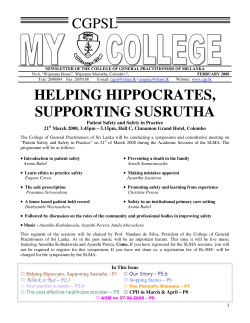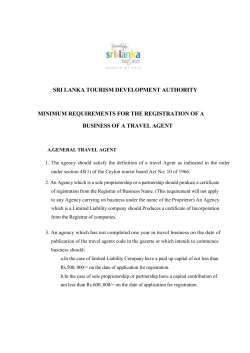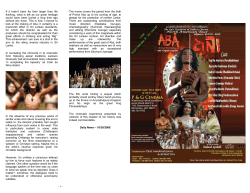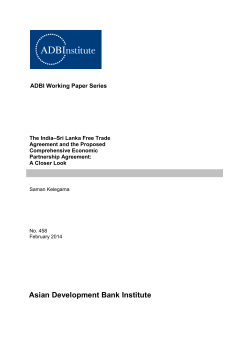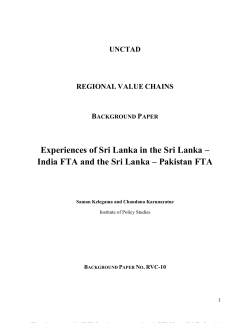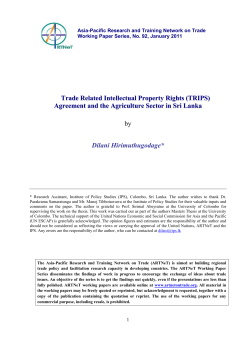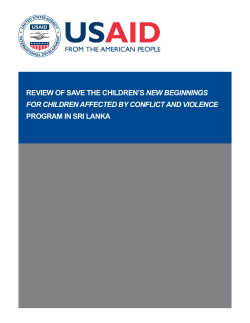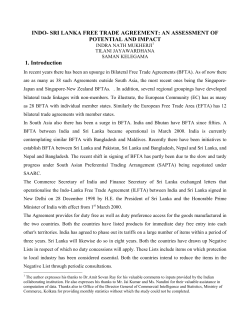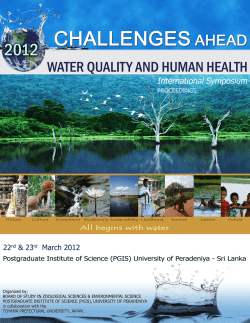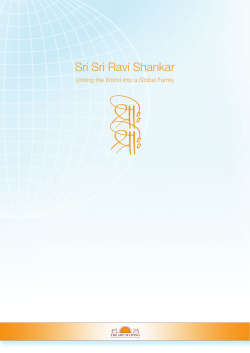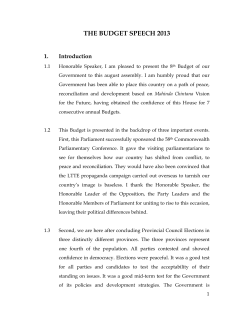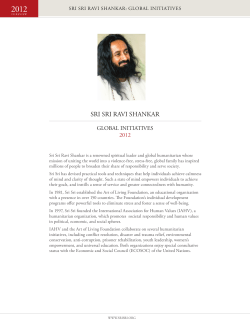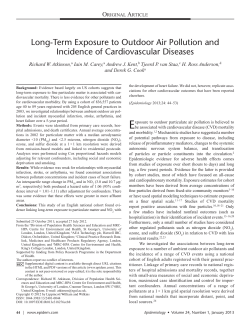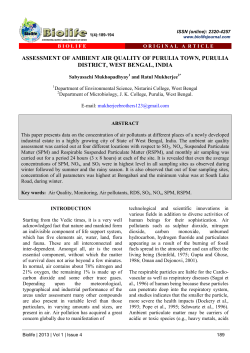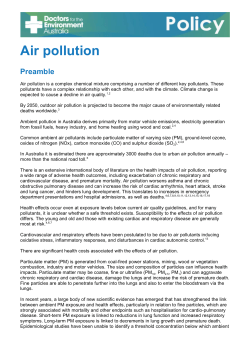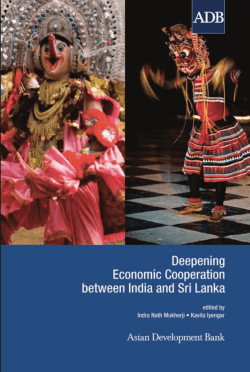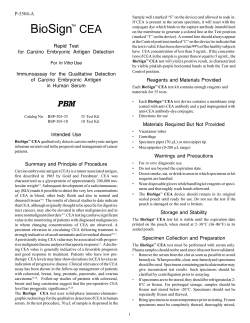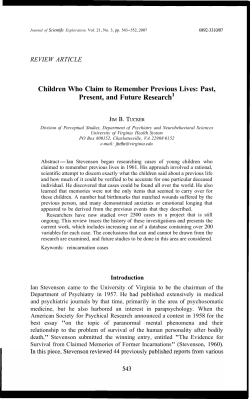
Sri Lanka
Sri Lanka Country Synthesis Report on Urban Air Quality Management Sri Lanka Discussion Draft, December 2006 © 2006 Asian Development Bank and the Clean Air Initiative for Asian Cities (CAI-Asia) Center. All rights reserved. Published 2006 by the Asian Development Bank (ADB). Printed in the Philippines. ADB facilitated this study through its Regional Technical Assistance 6291: Rolling Out Air Quality Management in Asia. The Study was led by the CAI-Asia Secretariat and the information contained in this report was developed by the CAI-Asia Secretariat with inputs by a range of organizations and air quality experts from across Asia and elsewhere. The views expressed in this report are those of the authors and do not necessarily reflect the views of ADB or its Board of Governors or the Governments they represent. ADB does not guarantee the accuracy of the data included in the publication and accepts no responsibility for any consequence of their use. The term “country” does not imply any judgment by ADB to the legal or other status of any territorial entity. Table of Contents Tables and Figures Abbreviations Acknowledgments iv v vi Conclusion 1 1 1 1 2 2 3 5 5 5 6 7 8 8 8 8 9 10 11 References 12 General Information Geography and Climate Urbanization and Population Economy and Industry Energy Transport Sources of Air Pollution Status of Air Quality Air Quality Monitoring Air Quality Data Air Quality Reporting Impacts of Air Pollution Air Quality Management Legal Basis and Mandate Air Quality Standards Management of Mobile Sources Management of Stationary Sources Public Participation Tables and Figures Tables 2.1 3.1 5.1 5.2 2002 and 2003 Emissions Inventory of Pollutants from Thermal Electricity Generation (’000 tons) Sri Lanka Air Quality Index Status of 49 Action Points Identified under the CA2AP, as of 2000 National Ambient Air Quality Standards Sri Lanka (μg/m3) 4 6 9 9 Figures 2.1 2.2 3.1 3.2 Contribution of Major Sectors of the Economy to SPM Emissions in Sri Lanka, 1997 Contribution of Major Sectors of the Economy to SO2 and NO2 Emissions in Sri Lanka, 1997 Annual Ambient Concentrations of PM10 in Colombo, 1998–2003 Annual Ambient Concentrations of SO2 in Colombo, 1998–2003 3 3 6 6 Abbreviations ADB AirMAC AQ AQM CAI-Asia CEA CMA CO GDP LPG MoF&E NBRO NGO NO NOx NO2 O3 Pb PM PM10 PM2.5 ppm SO2 SOx SPM ug/m3 USEPA WHO Asian Development Bank Air Resources Management Center air quality air quality management Clean Air Initiative for Asian Cities Central Environmental Authority Colombo Metropolitan Area Carbon monoxide gross domestic product liquefied petroleum gas Ministry of Forestry and Environment National Building Research Organisation nongovernment organization Nitrogen monoxide Nitrogen oxide Nitrogen dioxide ozone lead particulate matter particulate matter with diameter not more than 10 micrograms particulate matter with diameter not more 2.5 micrograms parts per million Sulfur dioxide Sulfur oxide suspended particulate matter microgram per cubic meter United States Environment Protection Agency World Health Organization Note: “$” means “US dollar” in this publication. Acknowledgments This series of country reports is the first time that a comprehensive overview of urban air quality management (AQM) at the country level has been prepared in Asia. Research compilation for this country synthesis report (CSR) on Urban Air Quality Management was led by the Clean Air Initiative for Asian Cities (CAI-Asia) Secretariat with inputs by a range of organizations and air quality experts from across Asia and elsewhere and facilitated by the Asian Development Bank (ADB) through its Regional Technical Assistance No. 6291: Rolling Out Air Quality Management in Asia. The primary authors of the reports are Ms. Aurora Fe Ables, Ms. May Ajero, Mr. Herbert Fabian, and Ms. Ninette Ramirez, all from CAIAsia, under the supervision of Mr. Cornie Huizenga, Head of Secretariat, CAI-Asia. The CSRs were prepared with assistance from volunteer authors from the different countries and facilitated by CAI-Asia local networks in Nepal (Clean Air Network-Nepal), Pakistan (Pakistan Clean Air Network), Philippines (Partnership for Clean Air [PCA]), the People’s Republic of China (PRC) (CAIAsia Project Office), Sri Lanka (Clean Air Sri Lanka), and Viet Nam (Viet Nam Clean Air Partnership). CAI-Asia local networks have also organized in the respective countries a development partners meeting on clean air where initial drafts of the CSRs were presented to local AQM stakeholders. For the Sri Lanka CSR, CAI-Asia extends special thanks to Mr. Rohan Samarakkody of National Building Research Organisation (NBRO), Ms. Bimalka Perera of Clean Air Sri Lanka, Mr. Ruwan Weerasoriya of Air Resources Management Center (AirMAC) and Mr. Don Jayaweera of Ministry of Finance and Planning for providing comments to the report. CAI-Asia would like to thank ADB for facilitating the research and Mr. Masami Tsuji, Senior Environment Specialist, Dr. David McCauley, Senior Environmental Economist, and Mr. Nessim Ahmad, Director—all from the Environment and Social Safeguard Division, Regional and Sustainable Development Department—for providing guidance. Ms. Glynda Bathan, Mr. Michael Co, Ms. Agatha Diaz, and Ms. Gianina Panopio of CAI-Asia are also acknowledged for their logistical and technical support for the CSR team. CAI-Asia and the respective country Ministries of Environments reviewed the volume—with technical review inputs from Prof. Frank Murray of Murdoch University—which Ms. Agnes Adre and Ms. Theresa Castillo copyedited. Mr. Segundo dela Cruz, Jr. handled the graphic design and layout. » Part One General Information Geography and Climate The Democratic Socialist Republic of Sri Lanka, known as Ceylon before 1972, lies in the Indian Ocean southwest of the Bay of Bengal. It is separated from the Indian subcontinent by the Gulf of Mannar and the Palk Strait. The pear-shape island consists mostly of flat to rolling coastal plains, with mountains rising only in the south-central part. The country is divided into 25 districts. Colombo is the capital city of Sri Lanka and lies in a coastal area in the lowlands on the southwestern part of the island. The city covers an area of 37.29 square kilometers (km2). It is strategically located as a seaport as planned during the early part of the 20th century (Liyanage 2003). Sri Lanka has a hot and humid tropical climate. Relative humidity in Colombo varies from 70–95 %. There are four rainfall seasons during the year: southwest monsoon period (May to September), northeast monsoon period (December to February) and two inter-monsoon periods (October to November), and (March to April). Monsoon rains account for approximately 55 % of annual precipitation. Colombo receives an average annual rainfall of approximately 2,400 mm and 140 rainy days. The mean annual temperature in Colombo is approximately 25 to 28oC with a small variation in the mean monthly temperatures throughout the year (Ministry of Environment and Natural Resources 2000). Urbanization and Population Mid-2005 estimates of Sri Lanka’s population is at 19.7 million, 15.1% of which live in the urban areas. The population has an annual growth rate of 1.3% annually, while the urban population grows at 0.5% per annum (Asian Develoment Bank [ADB] 2006). The last national census in 2001 reported a total population of 18,732,255 and a density of 299 persons per square km. As of 2001, Colombo district’s population was 2.23 million with a density of 3,305 persons per km2 (Department of Census and Statistics 2005). Approximately 50% of the population is estimated to be living in poverty. The 0.4% growth rate of the population from 1981 to 2001 is considered relatively slow compared to other Asian cities (Liyanage 2003). Economy and Industry Next to India, Sri Lanka is the country which exhibited high gross domesic product (GDP) growth rate in the South Asia region (India – 8.4%, Sri Lanka – 6.0%, and Bangladesh and Bhutan at 5.8% in 2005). Approximately half of the country’s GDP is attributed to the growing services sector (49.8 % in 1990 and 55.7% in 2005). The contributions of agriculture and industries to GDP, on the other hand, have been decreasing throughout 1990 to 2005—that is, agriculture – 22.9% to 17.2% and industry – 27.3% to 27.1%. Sri Lanka is historically famous for the production of cinnamon and tea since the 1800s but due to economic reforms, the most dynamic sectors now include food processing, textile and apparel, food and beverages, telecommunications, insurance, and banking. In 1970, crops dominated with 93% share in exports; but in 1996, this was reduced to 20%, while the share of textile and garments increased to 63% (Wikipedia 2006a). More than 80% of Sri Lanka’s industries (e.g., iron and steel, chemical, pulp, and paper) operate in close proximity to Colombo (Ministry of Forestry and Environment 2000). Although large-scale industries are not common, there is a big number of small- and medium-scale industries. 2 COUNTRY SYNTHESIS REPORT ON URBAN AIR QUALITY MANAGEMENT Industrial development in Sri Lanka is still at a stage where only a handful of very large-scale highly polluting type of industry exist but a large number of industries operate on small and medium scales. Compared to other countries in the region (such as India, Thailand, Indonesia, and Malaysia) the level of industrialization in Sri Lanka is relatively low. Except for a few thermal power plants, there are no large scale industry such as petrochemical industries and other chemical manufacturing plants of the scale found in neighboring countries. Energy Sri Lanka does not have any oil and natural gas reserves, so all petroleum products are imported and used for transport and power generation. In 2002, Sri Lanka’s oil consumption was estimated at 75,000 barrels/day. Sri Lanka does not produce nor consume any natural gas. The country has small coal reserves but does not consume any (Energy Information Administration [EIA] 2006). Biomass (47%), hydropower (8%), and petroleum (45%) are the main primary energy resources used in Sri Lanka, with a per-capita consumption of about 0.4 tons of oil equivalent (TOE). Electricity and petroleum products are the main forms of commercial energy, and an increasing amount of biomass is also commercially grown and traded. An estimated 70% of the national biomass consumption is in the informal sector, which is for household cooking, small commercial, and industrial applications. Industrial use has been in the traditional agricultural processing (rice, tea, rubber, coconut, and other crops) and in the building material industry (bricks and tiles). Biomass use in industry is growing as a result of price increases in petroleum fuels. Sri Lanka’s electricity consumption has been increasing through the years, doubling between 1992 and 2002. In 2005, electricity generation grew by 9.3%, and is expected to continue to grow at rates between 7—8% per year over the next 15 years. Currently, the national grid serves electricity to an estimated 73.2% of the households, while about 3% of the households are served by off-grid systems based on solar power or community hydro, wind, or biomass powered plants. The government intends to increase electricity infrastructure and provide 80% of the population electricity service coverage by 2010. In the past, most electricity requirements of the country (95%) were provided by hydropower (1995). Hydropower was vulnerable to fluctuations in rainfall, so the government intensified efforts to attract more investments in thermal power energy (EIA 2006). Transport Sri Lanka’s land transport system is predominantly road transport (93%), which is based mainly on a road network centered in Colombo. The existing rail network is no longer fit to meet the modern transportation requirements of the country (Wikipedia 2006b). The country’s strategic location in the South Asia region has contributed to its growth as a regional trading hub. In 2003, the transport sector has generated about 4% of direct employment and contributed to about 10% of the country’s GDP (World Bank 2006). The country’s road network has played an important role in facilitating the movement of people, goods, and economic growth. Roads are the primary means of people residing in the villages—that is, 65% of the country’s population—to access medical, education, market, and banking services. Throughout the years, however, uncontrolled roadside development as well as poor road maintenance has decreased travel speeds, hindering the economic growth of regions outside the Colombo Metropolitan Area (CMA). Past investments in the road sector have focused mostly on the rehabilitation of the existing road network and have not been geared toward addressing the rapidly growing freight and passenger traffic (World Bank 2006). In 2000, total active vehicle fleet in Sri Lanka was estimated to be 1.165 million, almost twice its size in 1991. In 2004, this further increased to 1.5 million. It is estimated that 60% of this fleet operate in the Colombo Metropolitan Region. Sri Lanka’s vehicle fleet is characterised by a large share of motorcyles (49% in 2000) which has shown significant increase in the past few years (Jayaweera 2002). Successive governments have undertaken several initiatives to reduce traffic congestion. These included the installation of automatic traffic signals where traffic jams are frequently experienced, the relocation of the administrative capital to Sri Jayewardenapura Kotte and the staggered opening and closing times of government and private establishments, factories and schools (Jayaweera 2001). » Part Two Sources of Air Pollution Emissions inventories are not routinely compiled in the country but are conducted mostly on ad hoc basis for academic purposes. Emissions inventories compiled by different groups also vary in terms of sectors, pollutants, and base years covered. It is also unclear whether these emissions inventories follow the same methodologies. For 1997, emissions inventory of suspended particulate matter (SPM) indicate that biomass burning contributes a large percentage (87.1%) to the total (Figure 2.1). On the other hand, transport sector emissions contribute the most emissions for SO2 and NO2 (Figure 2.2). FIGURE 2.2 Contribution of Major Sectors of the Economy to SO2 and NO2 Emissions in Sri Lanka, 1997 (a) SO2 Fuel conversion 4% Industry 7% Domestic 11% Power generation 30% Transport 48% FIGURE 2.1 Contribution of Major Sectors of the Economy to SPM Emissions in Sri Lanka, 1997 Industry 5.2% Power generation 0.3% Biomass burning 87.1% (b) NO2 Fuel conversion 0.1% Power generation 13.7% Industry 2.3% Transport 46.8% Vehicular traffic 7.4% Domestic 37.1% SPM = suspended particulate matter Source: Male Declaration, 2000. SO2 = Sulfur dioxide; NO2 = Nitrogen dioxide Source: Male Declaration, 2000. Sri Lanka’s energy mix has been changing from high dependence on hydropower to increasing use of thermal power. It is expected then that electricity generation, particularly from thermal power plants, can potentially contribute to air pollution. Of the installed 2,483 MW electric generation capacity in Sri Lanka, almost 50% comes from thermal power generation. Table 2.1 shows that emissions inventory of pollutants from these thermal power plants are increasing in both the western province and Colombo district areas. Through a technical assistance from the International Atomic Energy Agency, which started in 1998, the capacity of Sri Lanka to conduct source apportionment using nuclear analytical techniques has been enabled. In a monitoring study conducted between May 2002 and August 2004, it was revealed that 40% of PM10 fraction is composed of PM2.5 and that black carbon measurements of the filters indicate that combustion sources dominate (two thirds of total PM2.5) the fine fraction (Seneviratne et al 2004). 4 COUNTRY SYNTHESIS REPORT ON URBAN AIR QUALITY MANAGEMENT TABLE 2.1 2002 and 2003 Emissions Inventory of Pollutants from Thermal Electricity Generation (’000 tons) Particulate SO2 NOx Area 2002 2003 Inc, % 2002 2003 Inc, % 2002 2003 Inc, % Western Province 853.5 913.1 7 27.05 29.35 8.5 50.96 54.42 6.8 Colombo District 425.8 527.6 23.9 11.32 14.19 25.4 25.93 32.09 23.8 Other Provinces 100.3 87.4 -12.9 2.61 2.38 -8.9 6.12 5.31 -13.3 SO2 = Sulfur dioxide, NOx = Nitrogen dioxide, % = percent Source: Manthrinayake, and Samarkkody, 2004. » Part Three Status of Air Quality Air Quality Monitoring Mandate to monitor ambient air quality (AQ) in Sri Lanka is a responsibility of the Central Environmental Authority (CEA) but other organizations are also involved in monitoring AQ in Sri Lanka. As early as 1983, monitoring of AQ, particularly lead (Pb), was already being carried out in Colombo by the Chemistry Department of the University of Colombo. After which, from 1989 to 1992, three different organizations (National Building Research Organisation (NBRO), CEA, and the Ceylon Institute for Scientific and Industrial Research (CISIR, now Industrial Technology Institute [ITI]) conducted separate studies to contribute to understanding the AQ situation in Colombo (Male Declaration 2000). AQ monitoring in Colombo involved passive sampling techniques from 1989 to 1991 and active sampling from 1992 to 1993 by the NBRO (Premasiri 2004). Thereafter, automatic ambient AQ monitoring in Colombo started in December 1996 with two fixed AQ monitoring stations. These two automatic stations were originally located at the Fort railway station in the central business district of Colombo and at the meteorological station in the center of the city. These stations can measure the following pollutants: Sulfur dioxide (SO2), Nitrogen oxide (NOx), Nitrogen dioxide (NO2), Nitrogen monoxide (NO), Carbon monoxide (CO), ozone (O3), and particulate matter with diameter not more than 10 micrograms (PM10). The second station was later moved to the premises of CEA, the current operation status of which is unknown. The first station at the Fort is an area with high volumes of traffic, while the latter is with lower volume of vehicle traffic. These stations were purchased under the World Bank-funded Colombo Urban Transport Project executed by the Ministry of Transport. NBRO operated these stations until 2001 before handling the responsibility over to CEA. CEA contracted the monitoring work to NBRO mainly because of lack of technical staff at that time. Apart from these two fixed stations, one mobile station is also available for use in other areas whenever the need arises. It has been used to monitor AQ in areas outside the Colombo Metropolitan Region (CMR) namely, Hambantota in the south, Ambewela in the central hill region, Katugastota in the central region, Anuradhapura in the north central region, and Puttalam in the north western region (Jayaweera 2001, Malé Declaration 2000). Table 2.1 presents the specifications of the two fixed stations. The monitoring stations are automatically set for self-calibration using standard gases certified by the United States Environment Protection Agency (USEPA) at a set time each day (Malé Declaration 2000) Passive sampling techniques are also used to monitor AQ in industrial areas as well as other locations outside Colombo. Air Quality Data Annual average ambient PM10 levels in Colombo over the years have remained relatively stable within the 72 to 82 micrograms per cubic meter (μg/m3) range, peaking only in 2001. These values, however, consistently exceed the World Health Organization (WHO) annual guideline of 20μg/m3 for PM10. Sri Lanka has not set any ambient AQ standard for PM10. Despite high SO 2 emissions from industrial activities, especially power plants close to Colombo City, the ambient SO2 level in the city for 2003 fell within the annual USEPA limit of 78 μg/m3 (Sri Lanka does not have an annual standard for SO2). Unlike PM10, which was fairly stable within a small range of values, SO2 levels in Colombo have shown an increasing trend from 1997 to 2000 and then a general decreasing trend to 2003 (Figure 3.2). NO2 concentration levels in Colombo over the years have experienced the same pattern trends as with SO2—increasing 6 COUNTRY SYNTHESIS REPORT ON URBAN AIR QUALITY MANAGEMENT from 1998 to sometime 2001 then decreasing to 2003. Unlike SO2, however, annual NO2 in Colombo has exceeded WHO (2006) guideline of 40μg/m3 (Sri Lanka does not have an annual standard for NO2). FIGURE 3.1 Annual Ambient Concentrations of PM10 in Colombo, 1998–2003 µg/m3 Air Quality Reporting CEA has sole responsibility for the dissemination of data from the AQ monitoring program. Weekly AQs are reported in weekly average format as well as in AQ indices produced by CEA and disseminated to the media and made available online (e.g., AirMAC website: www.airmacsl.org/). The Sri Lanka AQ index values (Table 3.1) were formulated to help the public understand what local AQ means to their health. 90 TABLE 3.1 70 Sri Lanka Air Quality Index 50 Sri Lanka Air Quality Index 30 10 1998 1999 2000 2001 2002 2003 CEA = PM10 = particulate matter with diameter not more than 10 micrograms; μg/m3 = micrograms per cubic meter Source: CEA, 2006, as provided by AirMAC. Annual Ambient Concentrations of SO2 in Colombo, 1998–2003 µg/m3 70 60 50 40 30 20 1997 Color Code 0–50 Good Green 51–100 Moderate Yellow 101–150 Unhealthy for Sensitive Groups Pink 151–200 Unhealthy Red 201–300 Very Unhealthy Dark Red 301–500 Hazardous Maroon Source: AirMac website: www.airmacsl.org. FIGURE 3.2 10 Interpretation 1998 1999 2000 SO2 2001 2002 NO2 3 NO2 = Nitrogen dioxide; SO2 = Sulfur dioxide; μg/m = micrograms per cubic meter 2003 » Part Four Impacts of Air Pollution The impact of the phaseout of lead in gasoline has been studied by comparing the blood lead (Pb) levels of children respondents in 1998 (before phaseout) and 2003 (one year after introduction of unleaded petrol). The comparative analysis of the blood levels showed a statistical decline in the presence of Pb was observed, whereby, the percentage with levels above 10mg/dl had dropped from 6% to 0%. Venous and umbilical cord blood samples of 24 mothers and babies were also randomly selected from hospitals assayed for the presence of Pb in 2003. The levels in mothers and babies were compared. Only one mother-baby pair had no Pb in their blood. Seventeen of the 24 newborns, however, were found to have assayable quantities of lead in their blood. This has confirmed that although the problem of Pb in children has been significantly reduced, Pb passed on from mothers (through Pb stored in their bones) are a source of Pb to newborns. Pb from bones is released into the bloodstream of the mother during pregnancy due to demineralisation of the maternal skeleton (Senanayake et al. 2004). A study conducted by NBRO and the University of Colombo, Faculty of Medicine found a significant association between ambient air pollution (with respect to SO2 and NOx) and acute childhood wheezing episodes in Colombo . In this study, the correlation of the occurrence of maximum and minimum levels of SO2 and NOx were compared with the daily attendance of children experiencing wheezing (and requiring nebulization) were observed and found to be statistically significant (Senanayake et al. 1999). » Part Five Air Quality Management Legal Basis and Mandate The 1980 National Environmental Act (NEA) No. 47 was the first comprehensive legislation that encompassed environmental management and protection in Sri Lanka. CEA was established 1981 to implement the provisions of this Act. Since then, CEA has been instrumental in developing the necessary standards relevant for managing AQ in Colombo and for the rest of the country. The Ministry of Forestry and Environment (MoF&E) is the main institution for policy making and decision making. Although at present a majority of the pollution control programs are being implemented by the central Government through CEA, there is an increasing trend toward devolving the powers to the provinces. Currently, the North Western Provincial Council has its own statute and the Environmental Protection License program for industries is being administered through the provincial authority. This arrangement has encountered problems that include lack of personnel and lack of capacity to tackle major pollution problems arising from large-scale heavy industries. The division of responsibilities between provincial/local authorities versus the center requires clarification. At present, in the absence of fully functional provincial environmental agencies, there is no conflict between the center and the provinces. In the future, however, when the provincial authorities come into being, the respective roles of provincial authorities and the central Government will have to be clearly defined to avoid confusion. Air pollution in Sri Lanka had been recognized as a growing problem since the early 1990s. As a response, a strategy and action plan named the “Clean Air 2000 Action Plan” (CA2AP) was approved by the cabinet in 1993. This plan was one of the outputs of the Metropolitan Environment Improvement Programme supported by the World Bank. It covers recommendations for vehicle inspection and maintenance, fuel reformulation, monitoring of emissions, setting of standards, institutional strengthening, transport planning and traffic management, and the use of economic instruments. The expected result of which was to reduce all air pollutants of concern to CMA by 2000. 2000 reduction targets from 1990 levels include 40% for particulates; 40%, CO; 30%, NOx; 75%, oxides of sulfur; and 20% hydrocarbons. To reach these targets, 49 recommended actions under seven major issues were identified. Table 5.1 lists the status of these 49 action points as of 2000. Air Quality Standards CEA implements the National Environmental (Ambient AQ) Standards which were set out in the 1994 National Environmental Regulations (Table 5.2). The national ambient AQ standards of Sri Lanka is generally more lenient compared to the recently updated WHO (2006) guidelines. Management of Mobile Sources In 1998, the Environmental Foundation Limited (EFL) filed a fundamental rights lawsuit before the Supreme Court of Colombo against the MoF&E for failure to publish mobile emissions, fuel quality, and vehicle specification standards for the importation of vehicles as outlined in CA2AP. As a result, the Supreme Court ordered MoF&E to publish the standards. In June 2000 standards for mobile emission, fuel quality and vehicle importation were finally published and became effective on 1 January 2003. A 1997 Cabinet decision originally planned the introduction of Pb-free gasoline for 2010. However, a 2002 joint Cabinet 9 SRI LANKA TABLE 5.1 Status of 49 Action Points Identified under the CA2AP, as of 2000 Issue Number of Actions Actions Completed Actions in Progress Actions Not Initiated 6 1 4 1 10 4 3 3 Emission inventory and monitoring 5 3 2 0 Standard setting 9 2 3 4 11 4 5 2 Economic instruments 5 3 0 2 Transportation planning and traffic management 3 0 2 1 49 17 19 13 Vehicle inspection and maintenance Fuel reformulation, pricing, and fleet mix Institutional framework and regulatory compliance Total Source: Male Declaration, 2000. introduction of unleaded gasoline; and since July 2003, gasoline for high and low octane has been unleaded. TABLE 5.2 National Ambient Air Quality Standards Sri Lanka (μg/m3) Maximum Permissible Limita WHO Guidelinesb 8 hrs 10,000 10,000c 1 hr 30,000 30,000c 24 hrs 100 – Pollutant Averaging Time CO NO2 SO2 O3 Pb 8 hr 150 – 1 hr 250 200 1 yr – 40 24 hrs 80 20 8 hrs 120 – 1 hr 200 – 8 hrs – 100 1 hr 200 – 1 yr 0.5 0.5c 2 – 1 yr 100 – 24 hrs 300 – 8 hrs 350 – 3 hrs 450 – 1 hr 500 – 24 hrs SPM WHO = World Health Organization; CO = Carbon monoxide; hr = hour; NO2 = Nitrogen dioxide; O3 = ozone; Pb = lead; SO2 = Sulfur dioxide; SPM = suspended particulate matter; yr = year Source: a Government Gazette Extraordinary dated 20/12/1994; b WHO, 2006; and c WHO, 2000. memorandum of the Ministry of Environment and Natural Resources and the Ministry of Power and Energy on leadfree gasoline prohibited the manufacturing and sale of leaded gasoline (AirMAC 2004). This has caused the early Gasoline and diesel standards are stipulated in the 2000 National Environmental Regulation No. 01. For sulfur in diesel, the standards required that the maximum allowable sulfur level can only be 0.5 % (5,000 parts per million [ppm]) for 2003, up to 0.3 % (3,000 ppm) in 2004 and 0.05 % (500 ppm) in 2007 (The Island 2003). Management of Stationary Sources Industrial development in Sri Lanka is still at a stage where there are only a handful of very large-scale heavy industries. Compared to other countries in the region such as India, Thailand, Indonesia, and Malaysia, the level of industrialization in Sri Lanka is relatively low. There are no large-scale industries such as petrochemical industries and other chemical manufacturing plants of the scale found in neighboring countries. Given this situation, Sri Lanka is in a fortunate position where action could be initiated to ensure that when large-scale heavy industries come into the country, necessary infrastructure would be in place to ensure that the operation of such industries do not cause unacceptable levels of pollution. Under NEA, CEA is mandated to implement the two main regulatory provisions that relate to industrial pollution control. 10 COUNTRY SYNTHESIS REPORT ON URBAN AIR QUALITY MANAGEMENT These are the Environmental Protection License procedure for the control of industrial discharges; and the Environmental Impact Assessment procedure for major development projects, promulgated in February 1990 and June 1993, respectively (Ramani1998 ). The environmental protection license is required whether or not all waste-generating industries are of high- or lowpolluting nature. Annually, CEA is required to issue licenses to an estimated 25,000 to 30, 000 industries throughout Sri Lanka—a task which proved difficult even for the well-staffed agencies. As a consequence, some functions that relate to this licensing procedure of a number of low polluting industry sectors have been delegated to the local authorities (Ramani 1998 ). Under NEA’s provisions, only CEA is empowered to initiate legal action against high polluting industries violating the standards and criteria prescribed by CEA. As with the environmental protection licensing procedures, local authorities only have powers to initiate legal action against small-scale low polluting industry sectors (Ramani 1998 ). A number of regulatory- and incentive-based strategies are being implemented in Sri Lanka to assist industries in controlling pollution with special emphasis for “existing industries” that have been set up long before any of the present environmental regulations were promulgated. Some air quality management (AQM)-related programs to assist industries include: Pollution Control and Abatement Fund (PCAF), cleaner technology/waste minimization projects, and the relocation of selected industrial sectors. Public Participation To facilitate AQM programs in Colombo and the country, an Air Resource Management Centre (AirMAC) was formed in July 2001 under MoF&E. Since then, AirMAC has been instrumental in improving stakeholder participation in the country. AirMAC is formulating the Clean Air 2009 Action Plan which is still pending approval by the Cabinet of Ministers (Yalegama and Senanayake 2004). The plan aims to reduce vehicle emissions and improve fuel quality. » Part Six Conclusion AQM in Sri Lanka is largely focused in the capital where economic and urbanization activities are likewise centered. There is still very limited capacity to address air pollution and manage AQ in districts outside Colombo. AQ monitoring is routinely conducted only in Colombo and on an ad hoc basis only in other areas such as Kandy and Anuradhapura. Implementing AQ monitoring programs and reporting their results to the public in other urban areas may be an effective tool to increase awareness on air pollution in areas outside CMA, if resources are available to enable it.. The AQ problem of the country then is largely from mobile sources and electricity generation. Trends in energy consumption show increases in petroleum consumption compared with other renewable sources such as biofuels and hydropower. The country has also seen rapid motorization (e.g., doubling of motor vehicle fleet in one decade from 1991 to 2000). Particulate matter is the primary pollution of concern in Sri Lanka because it has consistently exceeded WHO guidelines. SO2 has shown increasing trends although they are still close to USEPA guidelines from 1997 to 2003. Annual NO2 levels, on the other hand, have consistently complied with WHO annual guidelines as well as annual USEPA limits. Sri Lanka is fortunate that public participation and interest in the air pollution problem is active as facilitated by AirMAC/and Clean Air Sri Lanka. AirMAC has likewise been actively promoting an updated Clean Air Action Plan which is pending approval by the Government. Focus on improved implementation and enforcement of laws and action plans should be a priority since implementation of previous action plans have been slow. References Asian Development Bank (ADB). 2006. Key Indicators. ADB. Manila. AirMAC. 2004. Email correspondence from Air Resources Management Centre (Sugath Yalegama). 16 July. Central Environment Authority (CEA). 2004. In document obtained from the Air Resources Management Center. Department of Census and Statistics. 2005. Census of Population and Housing 2001. Available at: www.statistics.gov. lk/population/index.htm. Last updated 11 March 2005. Energy Information Administration (EIA). Available at: www. eia.doe.gov/emeu/cabs/srilanka.html. Jayaweera. 2001. Vehicle Inspection and Maintenance Policies and Programme—Sri Lanka. Paper Submitted to the Global Initiative on Transport Emissions Asia Workshop. Bangkok, Thailand. 10–12 December. Jayaweera. 2002. Future Plans of the Air Resource Management Center (Mobile Sources)—Sri Lanka. Presented at the Side Event Partnership for Clean Fuels and Vehicles at the Better Air Quality Workshop in Hong Kong Convention and Exhibit Center. 16–17 December. Liyanage, J. 2003. Colombo Air Quality Management. Presented at the Kitakyushu Initiative Urban Air Quality Management Seminar in the United Nations Conference Center. Bangkok, Thailand. February. Available at: www.iges.or.jp/kitakyushu/ Meetings/Thematic%20Seminar/UAQM/Presentations/ Colombo/Colombo.pdf. Malé Declaration. 2000. Baseline Information and Action Plan. United Nations Environment Programme Regional Resource Centre for Asia and Pacific. Available at: www.rrcap.unep. org/issues/air/maledec/baseline/indexsri.html. Manthrinayake, M.A.L.S.N.K., and R.P. Samarkkody. 2004. Electricity and Air Emission. Presented during the “Air That We Breathe”: First National Symposium on Air Resource Management in Sri Lanka. 2–3 December. Sri Lanka. Ministry of Environment and Natural Resources. 2000. Initial National Communication under United Nations Framework Convention on Climate Change. Available at: http://unfccc. int/resource/docs/natc/srinc1.pdf. Premasiri, H.D.S., C.J. Annakkege, G.B.M.A. Basnayake, and R.P. Samarakkody. Identification of Critical and Sinking Areas in Colombo by Means of Spatial Air Quality Monitoring. Presented during the “Air That We Breathe”: First National Symposium on Air Resource Management in Sri Lanka. 2–3 December. Sri Lanka. Ramani, E.1998. Implementation of Industrial Pollution Control Programs in Sri Lanka. Paper presented at the Fifth International Conference on Environmental Compliance and Enforcement, Workshop 4D, Setting up and Managing Compliance Assistance Programs and Information Outreach on Regulatory Requirements, Monterey, California, 16–20 November. M.P. Senanayake, M.D.A. Rodrigo, and R. Malkanthi. 2004. Blood Lead Levels in Newborns and School Children in Colombo. Presented during the “Air That We Breathe”: First National Symposium on Air Resource Management in Sri Lanka. 2–3 December. Sri Lanka. Senanayake M.P., R.P. Samarakkody, S.R. Jasinghe, A.P. Hettiarachchi, S.P. Sumanasena, and J. Kudalugodaarachchi. 1999. Forestry and Environment Symposium 1999. Available at: http://ybiol.tripod.com/forest/99sympo/9924sena.htm. SRI LANKA 13 Seneviratne, M.C.S. et al. 2004. Air Pollution Monitoring using Nuclear Related Analytical Technique, Energy Dispersive X-Ray Fluorescence (ED-XRF) in Colombo. Presented during the “Air That We Breathe”: First National Symposium on Air Resource Management in Sri Lanka. 2–3 December. Sri Lanka. Wikipedia. 2006b. Transport in Sri Lanka. Available at: http:// en.wikipedia.org/wiki/Transport_in_Sri_Lanka. The Island. 2003. The Deadly Danger of Urban Air Pollution. Feature. Sunday, 18 May. Available: www.southasianmedia.net/ index_opinion3.cfm?id=4049&country=SRI%20LANKA. ———. 2006. WHO Air Quality guidelines for particulate matter, ozone, nitrogen dioxide and sulfur dioxide. Global update 2005. Summary of Risk Assessment. Available at: www. who.int/phe/air/aqg2006execsum.pdf. Yalegama, M.M.S.S.B, and N. Senanayake. 2004. Air Pollution and Contributions of Particulate Matter from Different Types of Diesel Vehicles in Sri Lanka. Paper Submitted to the Better Air Quality Workshop 2004. Agra, India. 6–8 December 2005. Available at: www.cleanairnet.org/baq2004/1527/article59285.html. Wikipedia. 2006a. Sri Lanka. Available: http://en.wikipedia. org/wiki/Sri_Lanka. World Health Organization (WHO). 2000. Guidelines for Air Quality. WHO/SDE/OEH/00.02. Geneva. Available at: http:// www.who.int/peh/. World Bank.2006.Sri Lanka Transport Sector.Available at: http:// web.worldbank.org/WBSITE/EXTERNAL/COUNTRIES/ SOUTHASIAEXT/EXTSARREGTOPTRANSPORT/contentM DK:20699037~menuPK:869140~pagePK:34004173~piPK:34 003707~theSitePK:579598,00.html.
© Copyright 2025
